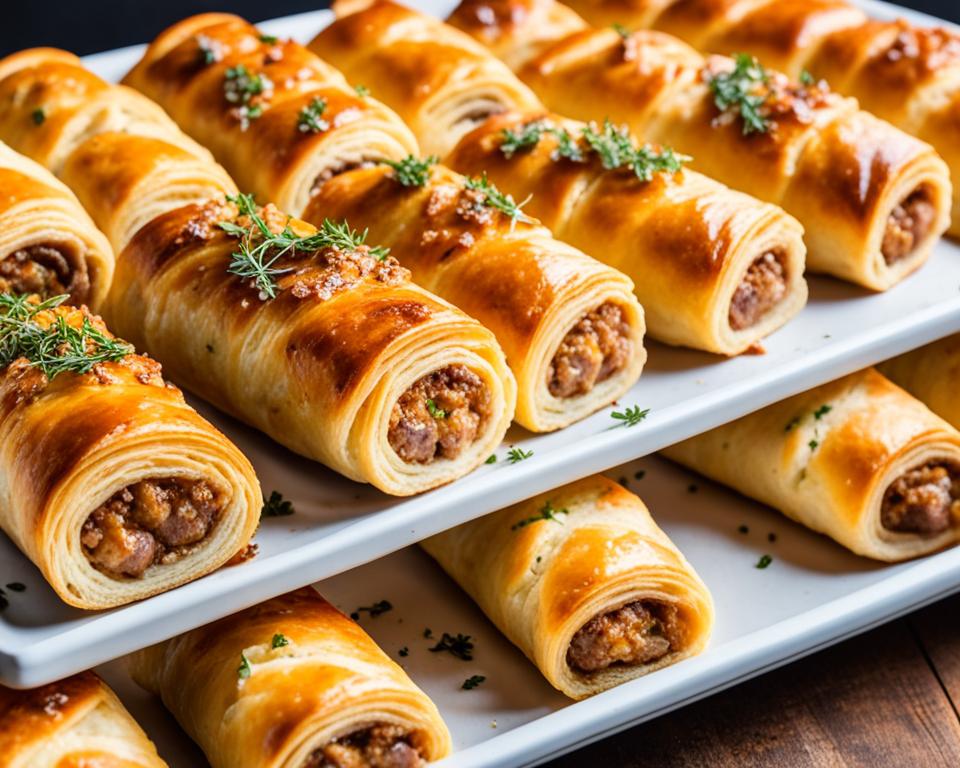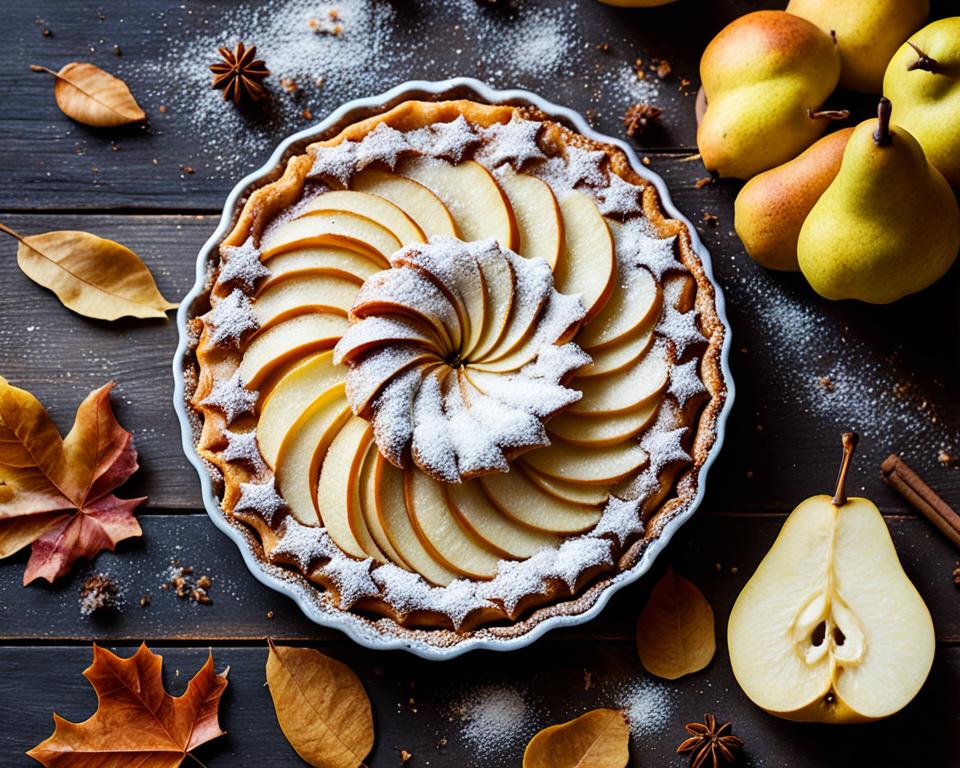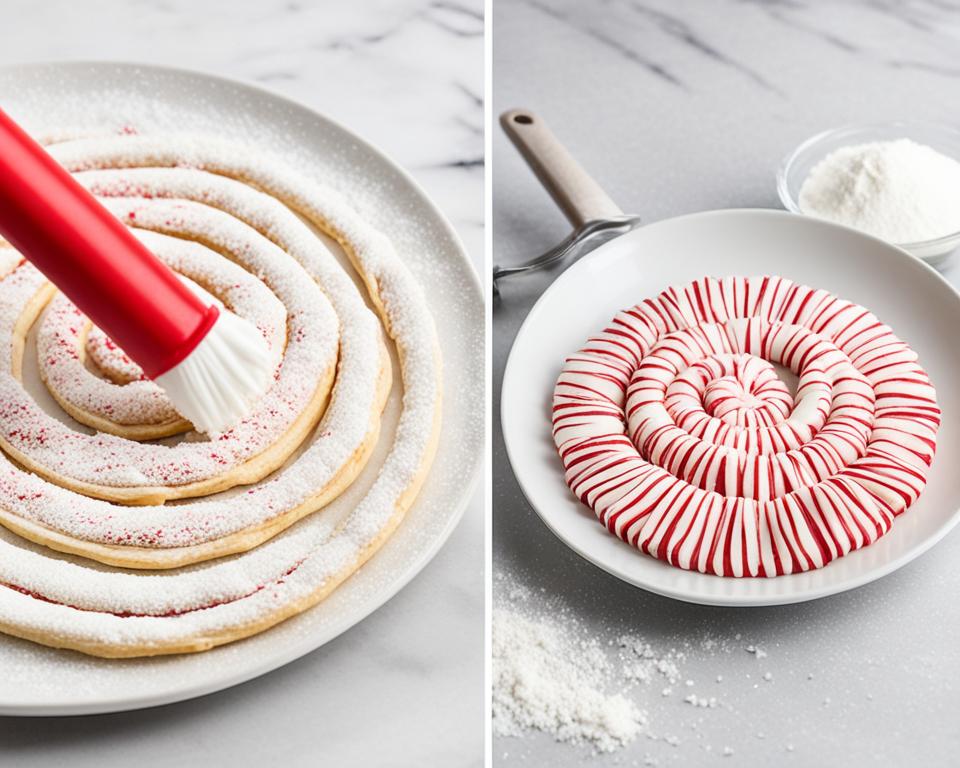Is there anything more indulgent than a homemade pastry still warm from the oven? Among the myriad of sweet confections, the flakiness and rich buttery layers of Kouign-Amann stand out as a testament to the art of French baking. Originating from the picturesque region of Brittany, these pastries entice with a golden, sugary crispness that’s often likened to the finest croissants. For those seeking simple dessert ideas or easy baking recipes, crafting Kouign-Amann at home may seem daunting, but with the right approach, it’s a delightful endeavor.
Whether you’re a seasoned baker or new to the realm of laminated dough, this guide demystifies the process, offering step-by-step photos, invaluable recipe notes, and a resourceful video to escort you through each stage. Turn your kitchen into a French patisserie and prepare to impress family and friends with flaky Kouign-Amann recipes that promise a taste of Brittany’s finest, in the comfort of your own home.
Key Takeaways
- Mastering Kouign-Amann requires patience and attention to the lamination process, ensuring those highly coveted flaky layers.
- With an array of step-by-step guides and visuals, even novice home bakers can confidently bake these homemade pastries.
- Choosing the right ingredients, particularly a high-quality butter, can significantly uplift the flavor and texture of your Kouign-Amann.
- While the total time investment is considerable, flaky Kouign-Amann recipes provide many opportunities for pauses, making them manageable for any schedule.
- Unlike some easy baking recipes, the satisfaction of peeling open the layers of your own Kouign-Amann is unparalleled, bringing simple dessert ideas to a new level.
Unveiling the Brittany Delight: Kouign-Amann Origins
Like a luxurious cloak woven with threads of sugar, flour, and butter, the Kouign-Amann is a masterpiece of French pastry unsurpassed in its opulence. The rustic region of Brittany, with its rich culinary heritage, lays claim to this sumptuous butter cake. Breton in birth, but universal in its appeal, its spiral of sweet layers tells a story of tradition and gastronomic finesse.
When one speaks of Kouign-Amann, it is not just a dessert being described, but an ode to centuries-old techniques of pastry perfection. In the quest to recreate authentic Flaky Kouign-Amann Recipes, it is essential to turn to its origins, uncovering how a simple concept evolves into a complex creation gracing the windows of patisseries and the tables of discerning gourmands.
The Roots of Kouign-Amann in Breton Culture
Emerging from the Celtic heartland of France, the Kouign-Amann carries with it the soul of Brittany. In the Breton language, “kouign” means cake and “amann” means butter – candid words for a pastry that epitomizes indulgence. With its rustic simplicity and rich taste, it has become an unmistakable signature of French pastry genius.
Laminated Dough: The Key to Flaky Kouign-Amann
To achieve the hallmark flakiness, a technique essential to making buttery pastry recipes comes into play – lamination. By intricately folding and rolling dough layers interspersed with butter, Kouign-Amann bakers navigate the fine line between art and science. Towards the end of its creation, sugar is judiciously folded in, crystallizing into caramelized edges as the pastry bakes. This labor of love results in a gastronomic narrative of texture and taste that echoes through each exquisite bite.
Flaky Kouign-Amann Recipes: A Step-By-Step Guide
The journey to creating authentic homemade pastries like Kouign-Amann begins with mastering the basics of yeast dough and understanding how to integrate butter into the mix for that melt-in-your-mouth texture. For enthusiasts of easy baking recipes and buttery pastry recipes alike, this guide lays out each critical step in crafting the perfect Kouign-Amann, ensuring that the process of lamination leads to the desirable, flaky outcome every time.
Understanding the Basics of Yeast Dough
At the heart of every Kouign-Amann is a yeast dough, simple yet capable of rising to the occasion. By combining room-temperature water with instant yeast, this stage sets the foundation for your homemade pastries. The fusion of all-purpose flour and a pinch of salt follows, converting into a supple dough through gentle kneading, ready to embrace its buttery counterpart.
Butter Incorporation Techniques
Adding luscious layers of butter to the dough is what distinguishes Kouign-Amann from other pastries. This transformative process involves meticulously folding cold, cubed butter into the dough, ensuring that each layer retains its integrity. Such careful integration contributes significantly to the rich, layered experience associated with the best buttery pastry recipes.
Crafting the Perfect Butter Block
- Chill and cube high-quality, salted butter.
- Beat until it reaches a homogenous, waxy texture.
- On parchment paper, shape butter into a neat rectangle.
- Cover then roll with a pin to create uniform thickness.
- Chill until firm yet pliable before the lamination process begins.
With these steps, you’re on your path to making delectable Kouign-Amann pastries that not only satisfy the craving for something sweet and buttery but also impress with their artisanal, handcrafted appearance.
The Art of Laminating Dough for Ultimate Flakiness
The pursuit of creating the perfect Flaky Kouign-Amann Recipe is much like a dance between baker and dough. It’s a meticulous and rhythmic process of folding and rolling that forms the heart of luscious homemade pastries. By mastering the art of laminating dough, one can transform simple ingredients into a sublime treat, reminiscent of the best patisseries in France. Join us as we delve into the techniques that will take your baking to new heights, ensuring flaky perfection with every bite of this delectable dessert.
Mastering the Folding and Rolling Technique
To achieve the trademark flakiness of Kouign-Amann, one must learn the delicate technique of folding and rolling dough. The process of lamination isn’t merely functional – it’s formative, allowing the dough to develop the airy, layered texture that defines this pastry. Integral to this process is the creation of butter layers, which puff up during baking to create the distinct flaky layers.
Executing the rolling and folding with precision is essential. The dough is first rolled out into a rectangle, and then a ‘butter block’, a rectangle of cold, pliable butter, is added. The dough is folded over it, akin to folding a letter, which is then repeated after rotating the dough. This layer-folding process, known colloquially as a ‘turn’, is repeated multiple times to maximize flakiness.
Chilling Strategies to Maintain Dough Integrity
Just as a skilled sculptor takes care in preserving the integrity of their materials, a baker must ensure the proper temperature of their dough. The chilling periods between each lamination turn are not mere pauses in the process but are instrumental in keeping the butter from melting into the dough, which can compromise those coveted layers.
It may be a test of patience, but placing the dough back into the refrigerator after each turn for about 30 minutes is a tried-and-true method to maintain its integrity. This chilling process stabilizes the butter, prevents it from melting during subsequent rolls, and ultimately, preserves the defining structure of your simple dessert idea. Below is a handy table illustrating the steps in the lamination process.
| Step | Process | Chilling Time | Necessity |
|---|---|---|---|
| Initial Roll | Roll dough and place butter block | None | Start lamination |
| First Turn | Fold the dough in thirds | 30 minutes | Begin creating layers |
| Second Turn | Rotate 90 degrees, roll, and fold | 30 minutes | Form additional layers |
| Subsequent Turns | Repeat rolling and folding | 30 minutes after each turn | Enhance layered structure |
| Final Rolling | Roll out for shaping/pastry cutting | None | Prepare for baking |
Sweet Sugary Layers: Transforming Your Pastries
Embark on a journey into the heart of French baking with Kouign-Amann—a sumptuous pastry that fuses the simplicity of butter and dough into a complex maze of delicate layers. This hallmark of Brittany not only dazzles the senses but also showcases the transformative power of sugar in easy baking recipes. When it comes to discovering simple dessert ideas, the secret lies within these sugar-dusted, butter-enriched laminations.
Lamination is paramount in achieving the signature flaky texture of buttery pastry recipes. However, the art of crafting Kouign-Amann pushes traditional boundaries by integrating sugar into the process, a step that forms its caramelized crust. Before the final folds that dictate the pastry’s shape, an even scattering of sugar lays foundation for a future golden allure and an indulgent, crisp bite.
Once laminated with sugary layers, the dough is rolled out one final time, cut into precise squares, and artfully manipulated into the pastry’s iconic shape. The preparation that goes into this delicate dance between dough and sugar does not go unnoticed. Patience and attentive crafting give way to a dessert that bakes into a visage of tempting golden edges and a hint of irresistible caramelization. To guide you through this decisive step of the baking process, below is a step-by-step overview:
- Prepare Your Workstation: Before the penultimate phase of folding, ensure your workstation is clean, with granulated sugar spread uniformly across the surface—a setting ready for transformative baking magic.
- Dusting with Sugar: In addition to the workstation, shower the top of your laminated dough with a generous layer of sugar, priming it for a caramelized finish once baked.
- The Final Folds: Proceed with the last two folds, pressing the sugar into the dough’s memory. Each fold encapsulates sweetness within the heart of the pastry, set to crystallize upon encountering the oven’s warmth.
- Shaping into Perfection: After completing the folds, roll out the dough, and cut it into squares. As you pick up each square, fold the corners towards the center, forming the pastry into its classic, crown-like configuration.
- Final Rise and Bake: Place your shaped Kouign-Amann into a well-buttered muffin tin and let rise. Once puffed, bake until each pastry portraits a golden-brown hue and the aroma of butter and caramel wafts through the kitchen.
When the baking is complete and your pastries have emerged from the oven, bursting with layers upon layers of flaky goodness, you’ll understand why Kouign-Amann reigns supreme amongst simple dessert ideas. With these easy baking recipes, you can recreate the elegance and richness of French buttery pastry recipes in your own kitchen. Kouign-Amann exemplifies the enchanting alchemy of baking—a celebration of flavor and technique.
Shaping and Baking: Achieving the Ideal Texture
Once the lamination of dough is complete, where buttery sheets are cocooned one after the other, we approach the shaping phase—a crucial juncture in bringing to life the exquisite treasure of homemade pastries. With deftness and a clear vision for dessert success, home bakers can witness the transformation of flat dough into the distinctive form of a classic French pastry. The process seamlessly leads to baking, where the dough rises to the occasion, christening each creation with a golden crown.
Creating Kouign-Amann Squares
The defeated dough must now be rolled and coaxed into its final shape, marking the birth of a potential confectionery delight. It is the careful cut—the creation of precise squares—that allows the dough to prepare for its ultimate metamorphosis. In the culinary ballet of folding corners to their center, these precursors of simple dessert ideas are tucked snugly into their buttered tins and left to mature in their doughy repose.
Tips for a Golden Brown Finish
The oven, with its promise of alchemy, ushers in the age-old tradition of baking, a pivotal moment where the essence of French pastry elegance is captured. Transformed under the confluence of heat, the Kouign-Amann’s texture shifts, melding crunch with tender, flaky layers. A symphony of colors emerges, and golden brown hues signal the perfect finish—emblems of a well-executed recipe. As the timer’s ring heralds completion, an immediate rescue from their tin fortress is imperative; this swift action circumvents the sugar’s protest, ensuring pastries release willingly, their flaky glory intact.
- Aim for uniform shapes when cutting squares to ensure even baking and presentation.
- Gently press the dough into the muffin tins to avoid deflation, and to hold the iconic shape.
- Monitor closely in the oven, seeking that delicate balance between golden and overly caramelized.
- Always remove Kouign-Amann from tins while they’re warm to prevent the caramelized sugar from hardening.
The distinction of textures, where softened butter meets the crispness of sugar, set against a background of golden dough, is what places Kouign-Amann among the upper echelons of cherished homemade pastries. Through these methods, even the novice baker can bring the allure of French pastry into their personal repertoire of simple dessert ideas.
Making Kouign-Amann Without a Mixer
There’s no need to shy away from trying your hand at flaky Kouign-Amann recipes even if a mixer is not part of your kitchen arsenal. Engage with the craft of easy baking recipes using traditional tools and techniques that bakers have employed for centuries. Through a hands-on approach, you can create a buttery pastry with textures and layers that rival any bakery production.
Hand Technique to Soften Butter
The secret to a pliable butter block without the use of mixers lies in the age-old technique of hand pounding and folding. This method is essential for those with a passion for buttery pastry recipes, as it aids in softening the butter to the ideal consistency. Achieving suppleness without melting retains the coldness crucial for successful lamination.
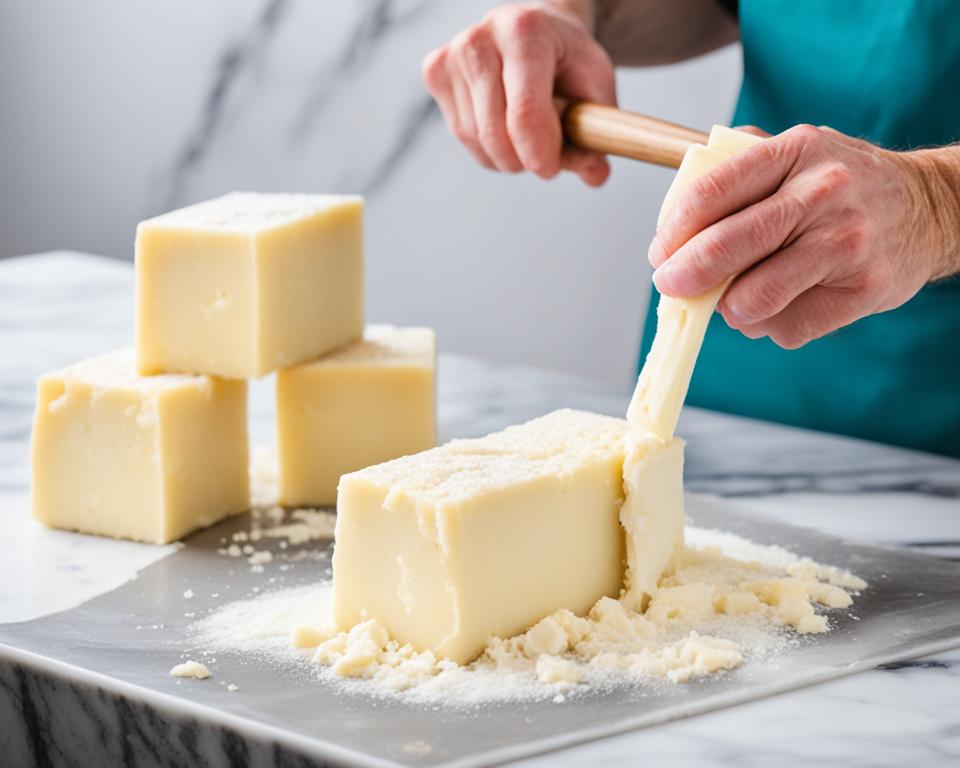
Knowing When the Dough is Ready
As part of crafting easy baking recipes like Kouign-Amann, gauging the dough’s readiness is imperative. It must strike a perfect balance between wet and dry – a condition that signals it’s time to envelope the butter. Flaky Kouign-Amann recipes rely on a meticulous eye for such detail, ensuring the final product has the ideal texture for this beloved French pastry.
To assist in creating the light, buttery layers that Kouign-Amann is known for, here are step-by-step instructions for preparing the butter and dough by hand – no mixer required:
- Begin by cubing the chilled butter and laying it out on a clean surface sprinkled with flour.
- Using a rolling pin, start tapping and then pounding the butter to coax it into a supple state, adding flour as necessary to prevent sticking.
- Once pliable, shape the butter into a rectangle roughly 6 by 10 inches in size, being careful not to overwork it. Wrap it and chill briefly.
- While the butter is chilling, turn your attention to the dough. Use just enough flour to keep the dough from sticking, kneading until it’s smooth, slightly tacky, and ready for the butter incorporation.
- Roll out the dough and encase the butter block within, folding the dough in a letter-fold manner, ready for the first turn.
Even without modern conveniences like mixers, achieving flaky excellence in your homemade pastries is within reach. Flaky Kouign-Amann recipes aren’t just for the professional chefs but for anyone who desires to partake in the joy of easy baking recipes. The traditional hand technique for softening butter and attentiveness to dough consistency can lead to remarkably buttery pastry recipes that dazzle with each flaky layer.
Versatility in Flavor: Cinnamon-Sugar and Other Variations
The journey of creating quintessential homemade pastries like Kouign-Amann is one of tradition melded with personal touch. Renowned for the classic combination of butter and sugar, these sumptuous treats can be adorned with imaginative flavors and fillings that add unique twists to simple dessert ideas. By embracing variety, bakers have the opportunity to cater to a wide array of palates while still honoring the technique and artistry of buttery pastry recipes.
For those eager to explore beyond the basic recipe, a world of taste awaits with adaptations such as cinnamon sugar, which introduces a comforting warmth to the pastry’s crisp flakiness. The option to insert a secret burst of flavor in the center – be it a dollop of jam, a swirl of salted caramel, or the luxurious melt of chocolate – turns each bite into a delectable surprise that elevates the humble Kouign-Amann to a gourmet experience.
Below is a table showcasing potential flavor variations and their corresponding additions to the dough before the final folding stage. Each variant provides a distinct experience and underscores the Kouign-Amann’s inherent versatility. Whether you aim for an aromatic note with cinnamon or a richer, deeper taste with chocolate, these enhancements transform the traditional pastry into personalized treats reflective of individual preferences and playful culinary exploration.
| Flavor Variation | Addition to Dough | Notes |
|---|---|---|
| Cinnamon-Sugar Kouign-Amann | Mix ground cinnamon into sugar | Imparts a warm, spicy note |
| Fruity Jam Kouign-Amann | Spoonful of your favorite jam | Adds a burst of fruity sweetness |
| Salted Caramel Kouign-Amann | Drizzle of homemade or store-bought salted caramel | Brings a silky, rich flavor with a hint of saltiness |
| Chocolate Stuffed Kouign-Amann | Chocolate chips or a small piece of chocolate bar | Creates a gooey, chocolaty center as it bakes |
The essence of crafting buttery pastry recipes like kouign-amann lies in the layers that convey both finesse and flavor. These variations allow for customizations that can turn a morning bake into a personal statement or sweetly punctuate an evening gathering. By integrating these different elements, the act of baking becomes an artistic expression, proving that simple dessert ideas can have the complexity and sophistication of the finest homemade pastries.
From Dough to Delicious: The Baking Timeline
The journey of transforming a humble mix of ingredients into exquisite Flaky Kouign-Amann Recipes may span just a few hours but requires precision and patience. These homemade pastries epitomize the joy of easy baking recipes, taking you through an enriching culinary timeline from initial preparation to the revelatory baking culmination.
Below is a breakdown of the baking process which not only details the time commitment involved but also highlights the meticulous steps necessary for achieving those flaky, golden-brown delights synonymous with the finest Kouign-Amann.
| Stage | Description | Duration |
|---|---|---|
| 1. Preparing the Dough | Mixing and kneading to form the base for lamination. | 1 hour |
| 2. First Rest | Allowing the dough to rise and double in size. | 1.5 hours |
| 3. Butter Block Formation | Beating and shaping butter for layering. | 10 minutes (plus chilling) |
| 4. Laminating Dough | Folding and rolling the butter into the dough with chilling intervals. | 2 hours |
| 5. Shaping | Cutting and forming the pastries into their traditional shape. | 30 minutes |
| 6. Final Proofing | Allowing shaped dough to puff up in the tin. | 45 minutes |
| 7. Baking | Waiting for the pastries to reach the perfect golden hue. | 25-30 minutes |
| 8. Cooling | Letting the pastries cool down to achieve their ideal texture. | 15 minutes |
Given that the entire process takes approximately 4 hours and 35 minutes, planning is key—whether you’re embarking on a leisurely baking day or scheduling it across breaks in your day. Keep in mind that the mouthwatering flakiness of Kouign-Amann is best enjoyed when the pastries have cooled sufficiently, a step that solidifies the layers and crystallizes the sugar. However, for those captivated by the scent of fresh sweets, sneaking a taste while they are still slightly warm is an irresistible pleasure.
Kouign-Amann: A Pastry to Savor Warm or Cool?
Delving into the heart of French pastry, the Kouign-Amann presents a delightful quandary—should it be enjoyed fresh out of the oven or allowed to cool to a crunchy perfection? This is a question that pastry aficionados have pondered with each flaky layer savored. While the temptation to consume this delectable creation warm is strong, part of the beauty of Flaky Kouign-Amann Recipes lies in the pastry’s transformative cooling stage.
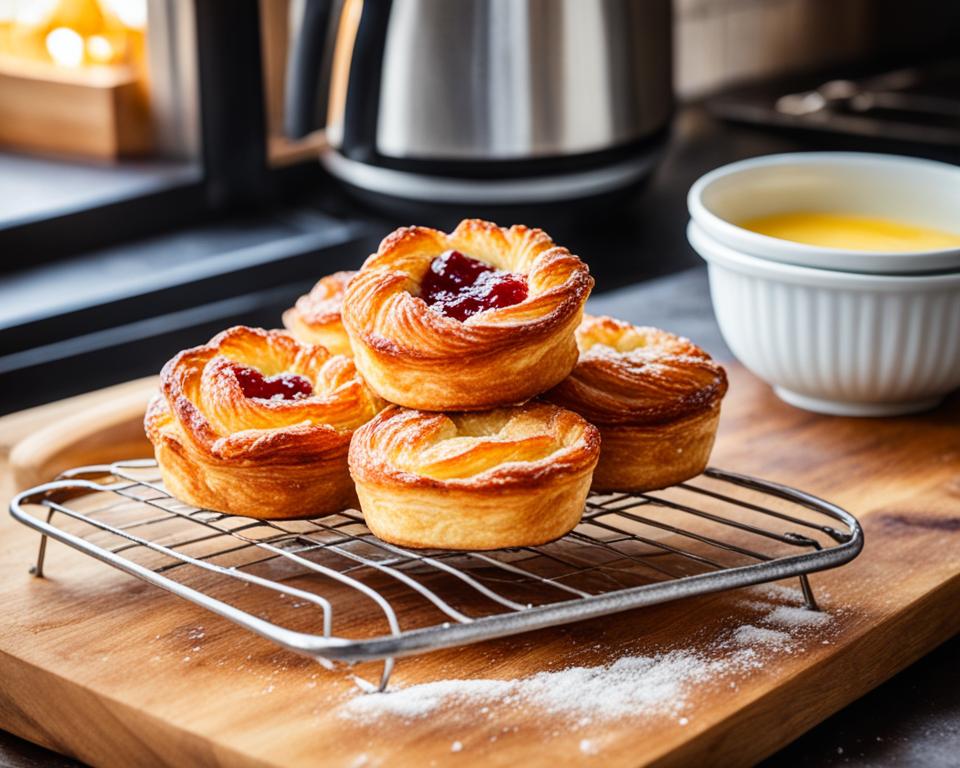
The Kouign-Amann promises a soft, melt-in-your-mouth experience when eaten warm. But it’s when these French masterpieces cool that their true depth of texture and flavor emerges. The cooling process sets the intricate layers into a state of sublime crispness, offering a contrast of textures that are at once tender and satisfyingly snappy. It solidifies them into their flaky, golden state and showcases the Kouign-Amann in its full, sugary glory—a testament to the skill that went into its creation.
- Warm Kouign-Amann: Enjoys a slight gooeyness, reminiscent of a freshly baked sweet roll.
- Cooled Kouign-Amann: Boasts a profound textural contrast and a full-bodied crunch that complements its buttery flavor.
Whether chosen as simple dessert ideas or as a luxurious indulgence, Kouign-Amann embody the versatility and sophistication of French baking. Their adaptable nature, delectable both warm or cool, makes them a seamless fit for any culinary occasion. Indulging in a piece of Kouign-Amann, regardless of its temperature, is to partake in a storied tradition of patisserie excellence, wrapped in each sugar-dusted, butter-laden bite.
Maximizing Freshness: Storage Tips for Kouign-Amann
For anyone who has spent time crafting homemade pastries, especially delicate treats like Kouign-Amann from easy baking recipes, knowing how to store them properly is as important as the baking process itself. These simple dessert ideas may be a joy to create, but the real pleasure comes from savoring them at their peak of freshness. To ensure the flakiness and crunch of Kouign-Amann don’t fade, proper storage techniques must be employed. Here’s a guide to keeping your pastries as irresistible as the moment they left the oven.
Room temperature storage is often the go-to method for keeping pastries fresh, especially for those planning to enjoy them within a day or two of baking. Opt for an airtight container to seal in the freshness, which helps maintain the integrity of those buttery, flaky layers. If Kouign-Amann are not destined for immediate consumption, freezing offers a solution to prolong their enjoyment while keeping the quality intact.
- The ideal time to enjoy Kouign-Amann is within the first 48 hours after exiting the oven.
- Until then, a tight seal in an airtight container at room temperature will preserve the quality.
For those who find themselves with more Kouign-Amann than can be consumed in a short period, freezing is an excellent option. Ensure the pastries are fully cooled to preserve the ideal texture and taste. Once chilled, wrap each Kouign-Amann individually in plastic wrap before placing it in a freezer-safe bag. This method keeps them ready for a quick thaw or a brief reheat, providing a near-fresh experience.
| Storage Method | Duration | Condition | Outcome |
|---|---|---|---|
| Room Temperature | 1-2 Days | Airtight Container | Preserves Freshness |
| Freezing | Up to 3 Months | Fully Cooled, Individually Wrapped | Maintains Quality |
By adhering to these storage tips, your Kouign-Amann will remain a delightful treat that continues to embody the essence of simple dessert ideas and the perfection of homemade pastries. So whether you’re sharing with friends or indulging in a personal treat, these pastries will taste as fresh as the day you baked them.
Choosing the Right Butter for Authentic French Pastry Results
When perfecting buttery pastry recipes, like the renowned Kouign-Amann, the quest for authenticity does not merely end with technique. The selection of ingredients plays a pivotal role in achieving that signature richness and flaky texture related to the finest French pastry delights. More than a mere ingredient, butter is the cornerstone of homemade pastries, casting an irrevocable influence over the final product’s taste and consistency.
European vs. American Butter
The age-old debate between European and American butter centers on one particular element distinguishing the two: fat content. European butter, often lauded for its superior quality, typically boasts a higher fat percentage, around 82% compared to the 80% commonly found in American butter. For aficionados of flaky layers and rich flavor that characterize traditional French pastry, European varieties offer a texture that is both sumptuous and indulgent.
Why Fat Content Matters
The higher fat content in European butter isn’t merely a number—it’s synonymous with flavor, moisture, and the ability to produce flaky layers in pastries. The lower water content and increased fat contribute to a more pliable dough, which becomes exceptionally crucial when laminating pastry dough, a process where butter layers intersperse between flour sheets. It is this extraordinary lamination that creates the flaky, airy textures one expects from homemade pastries like Kouign-Amann.
| Butter Type | Fat Content | Recommended Uses |
|---|---|---|
| European Butter | Approximately 82% | Perfect for laminating doughs, croissants, and other French pastries |
| American Butter | Approximately 80% | Suitable for general baking and cooking needs |
| Kerrygold (European) | Above 82% | Ideal for high-quality, rich-tasting homemade Kouign-Amann |
In conclusion, selecting the right butter is a nuanced decision; it’s an acknowledgement of tradition, a nod to French culinary excellence, and a commitment to recreating authentic homemade pastries. Brands like Kerrygold not only carry the high fat content necessary for exceptional Kouign-Amann but also provide a taste profile sought after by pastry connoisseurs globally.
Pastries for Every Occasion: Serving Ideas
Whether you are looking for simple dessert ideas or aiming to indulge in sophisticated homemade pastries, the versatile and flaky Kouign-Amann provides a wealth of possibilities perfect for any occasion. From a tranquil morning breakfast to an elegant afternoon snack, these layered delights can be easily personalized with your choice of fillings, ensuring each bite is as unique as the event itself.
For instance, imagine starting your day with a Kouign-Amann paired with a steaming cup of coffee, or offering them as a stylish dessert at your next dinner party. The rich, buttery layers of Flaky Kouign-Amann Recipes make a compelling case for their presence at any gathering, providing both a feast for the taste buds and the eyes. Let’s explore a range of serving ideas that cater to different tastes and settings:
- **Morning Bliss** – Kouign-Amann served with artisanal jams and fresh fruit preserves.
- **Afternoon Refinement** – Pair these pastries with a delicate selection of teas for a high-class treat.
- **Evening Sophistication** – Complement Kouign-Amann with a glass of sparkling wine or a dessert wine for an opulent finish to any meal.
- **Child’s Play** – Fill them with Nutella or a spoonful of peanut butter – a hit at children’s parties or as an after-school snack.
- **Seasonal Charm** – Customize fillings with seasonal flavors like pumpkin spice or peppermint around the holidays.
As we delve into these serving ideas, a table illustrating possible pairings with beverages and fillings enhances the scope of your next Kouign-Amann experience:
| Occasion | Beverage Pairing | Proposed Filling |
|---|---|---|
| Luxury Breakfast | French Press Coffee | Apricot Conserve |
| Tea Time | Chamomile Tea | Lemon Curd |
| Dinner Finale | Iced Dessert Wine | Salted Caramel |
| Kid-Friendly Snack | Milk | Chocolate Hazelnut Spread |
| Festive Celebration | Eggnog | Cinnamon Sugar |
These suggestions are mere starting points in the adventure of incorporating Kouign-Amann into various aspects of your culinary life. Their adaptability allows them to seamlessly blend into any gourmet context, elevating the simplest gatherings to a realm of understated sophistication.
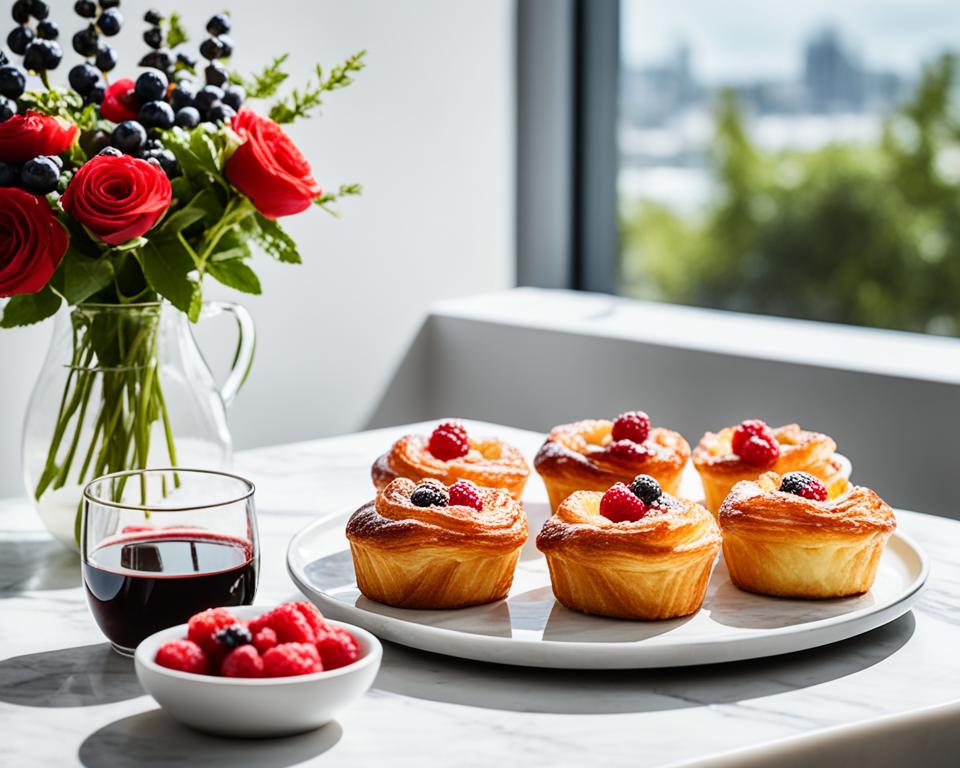
To further enhance the occasion, consider experimenting with presentation styles. A well-placed dollop of whipped cream or a tastefully arranged fruit garnish can transform the visual appeal and taste profile of this classic French pastry. There’s no limit to the creativity when you start with a foundation as delectable as the Kouign-Amann; each addition is a step towards creating an unforgettable eating experience.
Ultimately, this exploration into Flaky Kouign-Amann Recipes and serving ideas underscores the pastry’s standing as a versatile and beloved choice among simple dessert ideas. Whether dressed up for a special event or enjoyed in its pure, buttery form, the Kouign-Amann is a testament to the pleasures of fine baking and the joy it brings to every table it graces.
Freezing and Reheating Kouign-Amann: Keeping It Perfect
The allure of homemade pastries like Kouign-Amann lies not only in their fresh, flaky goodness but also in their flexibility to last beyond the day they are baked. For those who love to indulge in easy baking recipes but seek to extend the enjoyment of their labor, freezing Kouign-Amann presents an ideal solution. Dive into the nuances of preserving the buttery taste and delicate layers of these simple dessert ideas for later delight.
When it comes to homemade pastries, the readiness with which they can be preserved and later enjoyed is a huge boon, especially for busy baking enthusiasts. Kouign-Amann, much like other layered pastries, retains its quality when properly frozen after it has cooled. Storing these flaky treats in the freezer not only stretches out the period over which they can be savored but also maintains their artisanal quality.
Despite Kouign-Amann’s amenability to the deep cold of your freezer, it is important to note that this method is suited to pre-baked pieces. Unbaked pastries, designed in anticipation of future baking sessions, will not fare as well when frozen due to the sugar within the layers, which can liquify and change the pastry’s structure.
- Allow the baked Kouign-Amann to cool completely to preserve their texture.
- Wrap each pastry individually in plastic wrap, then place them in a zipper-lock freezer bag.
- When craving strikes, preheat your oven and place the still-frozen Kouign-Amann onto a baking sheet.
- Reheat for a brief time until they’re warm and refreshingly crisp on the outside.
Those looking to produce homemade pastries in large batches can take advantage of freezing and reheating techniques. The ability to freeze extends the life of each batch of Kouign-Amann up to three months, thereby transforming a single day’s work into a prolonged experience of flaky, buttery enjoyment.
| Stage | Advice | Expected Outcome |
|---|---|---|
| Pre-Bake Cooling | Allow pastries to reach room temperature to avoid condensation when freezing. | Pastries retain their ideal texture after thawing. |
| Freezing | Individually wrap pastries to minimize freezer burn and flavor transfer. | Maximize freshness and flavor integrity. |
| Reheating | Heat directly from the freezer without thawing to avoid sogginess. | Pastry layers remain crisp and buttery. |
Embracing the freeze-and-reheat method enriches the repertoire of anyone who enjoys baking and sharing these delightful homemade pastries, whether they’re an accomplished home chef or someone new to the joy of easy baking recipes. Kouign-Amann, once cooled, frozen, and reheated, still exemplifies the essence and satisfaction of simple dessert ideas, bringing the charm of French patisserie to any time of day or night.
Conclusion
The art of French pastry is epitomized in the flaky layers of Kouign-Amann, a delectable treat that invites bakers to explore the elegance and satisfaction woven into each sugary fold. With Flaky Kouign-Amann Recipes, the secrets of creating these homemade pastries are unraveled, providing a blueprint to the meticulous processes of kneading, lamination, and baking. It is a testament to the culinary heritage that a confection as refined as Kouign-Amann can be recreated in home kitchens across the United States, speaking to the accessibility and joy of easy baking recipes.
Every layer of these buttery pastry recipes whispers the importance of selecting high-quality ingredients, with European butter’s higher fat content making a notable difference in achieving that authentic richness beloved by pastry aficionados. Furthermore, the longevity and enjoyment of these pastries are greatly enhanced by proper storage techniques, ensuring that each bite maintains its integrity, whether savored fresh or revived from the freezer.
Whether one indulges in Kouign-Amann as a simple dessert idea after a meal or relishes it as part of a sumptuous breakfast spread, these homemade pastries represent more than just a recipe—they embody a sensory journey through the heart of French pastry tradition. Within the pages of these recipes, one discovers not just the methods behind creating flaky delights but a piece of cultural artistry to cherish, discuss, and most importantly, enjoy.
FAQ
What are the origins of Kouign-Amann?
Kouign-Amann is a traditional pastry from the Brittany region of France, known for its buttery, sugary layers. The name translates to “butter cake” in the Breton language, and it’s famous for its rich, laminated dough that’s similar to croissants in texture.
How do you incorporate butter into Kouign-Amann dough?
Butter is incorporated into Kouign-Amann dough by creating a butter block and laminating it with the dough. This is done by folding and rolling the dough several times to create thin layers of butter between the dough, which results in the flaky texture once baked.
Can I make Kouign-Amann without a mixer?
Yes, Kouign-Amann can be made without a mixer. Butter can be prepared by hand by pounding and folding it until it becomes malleable. Be attentive to the dough’s consistency, adjusting with flour or water as needed to reach the ideal texture for rolling and folding.
How long does it take to make Kouign-Amann from start to finish?
The entire process for making Kouign-Amann takes about four and a half hours, including preparing the dough, resting, refrigerating, and baking. This time investment results in a pastry with a unique flaky texture and caramelized sugar layers.
How should Kouign-Amann be stored to maintain its freshness?
Kouign-Amann should be stored at room temperature in an airtight container for short-term freshness. They are best eaten within two days of baking. For longer storage, cool the pastries completely before freezing them. They can then be reheated to restore their flaky texture.
Can you freeze and reheat Kouign-Amann?
Yes, fully cooled Kouign-Amann can be frozen and will retain their quality for up to three months. Reheat them in the oven to recapture the pastry’s flaky texture and buttery taste.
What type of butter is best for making Kouign-Amann?
High-fat European-style butter is the best choice for Kouign-Amann. Brands like Kerrygold are known for high butterfat content, which contributes to a richer flavor and texture in the pastry, aligning with authentic French pastry standards.
Are there variations of the classic Kouign-Amann recipe?
Yes, while the classic Kouign-Amann is a sugary, buttery treat, there are variations that include cinnamon-sugar, jam, salted caramel, or chocolate to add a different twist and cater to a variety of tastes.
Is Kouign-Amann suitable for different occasions?
Certainly, Kouign-Amann is versatile enough to be served as an indulgent breakfast, an elegant dessert, or a gourmet snack for afternoon tea. With the ability to customize filling choices, it can suit a wide range of occasions and culinary preferences.
What’s the key to achieving the perfect flaky texture in Kouign-Amann?
The key to the flaky texture is the lamination process; carefully folding and rolling the dough with a butter block to create multiple layers. The dough should be kept chilled between turns to maintain its integrity and prevent the butter from leaking out.


